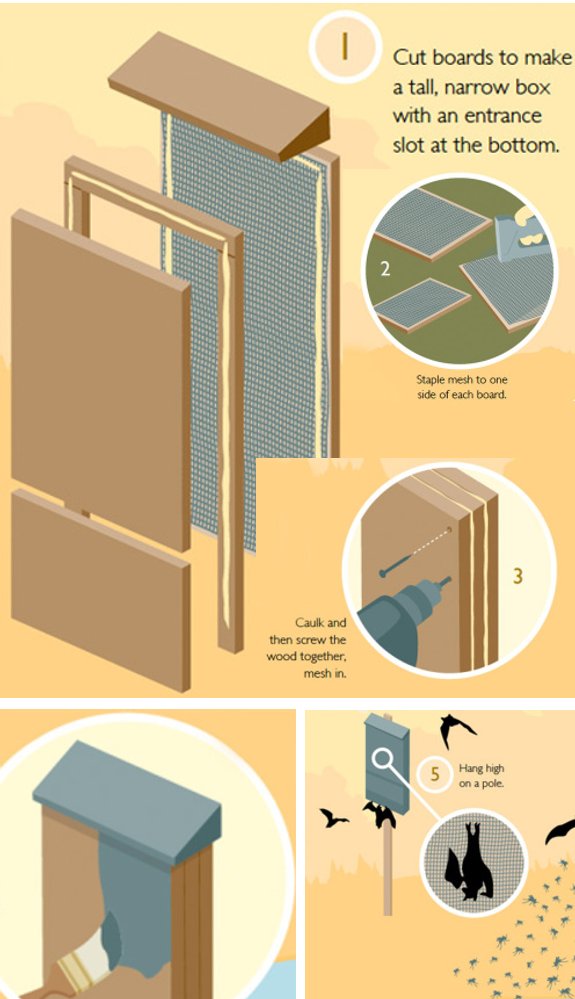
Best bat box design for guano harvesting

In your agrarian situation, do bats have a place in your plans?
Vester
That question brings up a
project that's been on the back burner for a while now.
I'm thinking the shady side
of our barn would be a good place to mount a few bat boxs and maybe a
bed of straw at the bottom to catch any potential guano.
Image credit goes to Lauren
Smith and Derek Fagerstrom from their intriguing book titled "More Show
Me How".
Want more in-depth information? Browse through our books.
Or explore more posts by date or by subject.
About us: Anna Hess and Mark Hamilton spent over a decade living self-sufficiently in the mountains of Virginia before moving north to start over from scratch in the foothills of Ohio. They've experimented with permaculture, no-till gardening, trailersteading, home-based microbusinesses and much more, writing about their adventures in both blogs and books.
Want to be notified when new comments are posted on this page? Click on the RSS button after you add a comment to subscribe to the comment feed, or simply check the box beside "email replies to me" while writing your comment.

Thanks for the question Robert.
MAXIMUM DIMENSIONS – MODEL 1 Drawing LCC 851 In a temperate climate, this model is more likely to be used by hollow-roosting bats in the cooler months. Timber thickness – 45mm (except for the 20mm internal block) Back Height 851mm, Width 250mm Sides x two Height 541mm, Width 100mm Front Height 505mm (200 bevelled edge), Width 250mm Base Depth 160mm, Width 80mm (Provides for 20mm entrance) Inspection lid Depth 205mm (200 bevelled edge), Width 300mm This dimension allows a 25mm over-hang of the lid on each side and at the front of the box. Internal block 20mm thick. Measure internal block dimensions to suit after assembly of box. Weathering may cause the box to contract. Consequently, ensure that the internal block when screwed to the inspection lid allows the lid to close freely.
The entrance also depends on which species you are trying to attract.
TARGET SPECIES IN GIPPSLAND HOLLOW-ROOSTING BATS Target species for 12 to 15mm base entrance Chocolate Wattled Bat Chalinolobus morio Eastern Freetail Bat Mormopterus sp. Gould’s Long-eared Bat Nyctophilus gouldi Lesser Long-eared Bat Nyctophilus geoffroyi Large Forest Bat Vespadelus darlingtoni Southern Forest Bat Vespadelus regulus Little Forest Bat Vespadelus vulturnus Target species for 15 to 20mm base entrance Gould’s Wattled Bat Chalinolobus gouldii Eastern False Pipistrelle Falsistrellus tasmaniensis Southern Myotis Myotis macropus Eastern Broad-nosed Bat Scotorepens orion Target species for 15 to 25mm base entrance White-striped Freetail Bat Tadarida australis Target species for 25 to 35mm base entrance Yellow-bellied Sheathtail Bat Saccolaimus flaviventris The White-striped Free-tail Bat and the Yellow-bellied Sheathtail Bat are high-flying bats and probably roost higher than other hollow-roosting bats. Smaller bat species are unlikely to roost in bat roost boxes with a base entrance targeted towards the larger species. Bats usually select roosts with entrances only marginally bigger than the thickness of their skull and chest. This protects bats from predation and from competition from larger mammals and birds. As most bats found in Gippsland are very small (4 to 20 grams), entrances for bat roost boxes also need to be small. It is strongly recommended that when installing bat roost boxes the emphasis is placed upon constructing bat roost boxes with a base entrance ranging from 12 to 20mm.